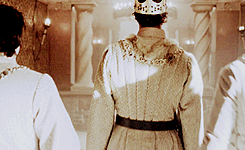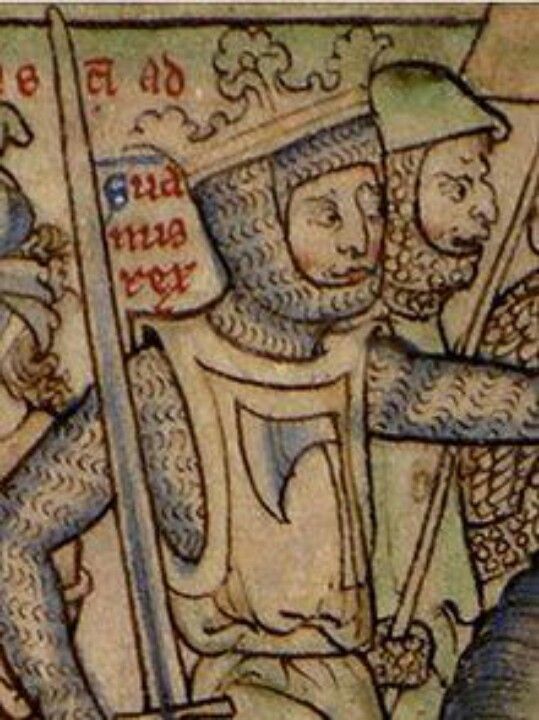#Aelfgifu Regina
Text
the encomium emmae reginae is a delight to read, by the way. the encomiast spends page after page talking about how sweyn and canute are sooo cool and then when it comes to aethelred ii he’s like uh who’s that. he blatantly makes shit up. ‘oh right here’s the full text of the forged letter harold harefoot sent to emma’s sons pretending to be her so he could entrap them because he’s a hater and maybe not even actually canute’s son by aelfgifu the concubine.’ he so desperately wants to call godwin a traitor but he’s only allowed to imply it. fun stuff.
7 notes
·
View notes
Photo






“1002 was a seminal year in the life of the king and his kingdom. The first significant event that took place was the marriage of Aethelred to Emma of Normandy. In 1002, Emma was about seventeen years of age. She was the daughter of Richard I, Duke of Normandy, the place where the Vikings had taken up permanent residence under Duke Rollo not so many years before.
Emma was herself the great-granddaughter of Rollo and the blood of her Viking ancestors still coursed through her veins. The blood relationship was cemented still further by the fact that her mother was Gunnar, a woman of Danish descent. Gunnar was originally Richard’s concubine, though she eventually became his wife in a probable attempt to legitimise their children.
[...] The marriage to Aethelred was a set up to Emma. Allowing for any perceived personal faults and the extent of the challenges facing him, he was still a king, a man who owed allegiance to no other, unlike the dukes of Normandy, who were vassals to the King of France.
This presumably also helped compensate to some extent the substantial age difference between the young bride and her husband, who already had a large number of children from previous relationships. [...] It seems that right from the off it was decided that any offspring from this match with Emma were to take precedence over those previous relationships in matters of succession.
[...] Other later chronicles commented on the match, not always favourably. With the precious gift of hindsight and writing from the safe distance of the middle of the twelfth century, the chronicler Henry of Huntingdon saw the marriage as a turning point in English history:
“I mean that on one side the persecution by the Danes was raging, and on the other the connection with the Normans was growing, so that even if they were to escape the obvious lightning fire of the Danes, valour would not help them to escape the insidious danger from the Normans. This became apparent from subsequent events, since from this union of the English king with the daughter of the Norman duke, the Normans were justified according to the laws of peoples, in both claiming and gaining possession of England.”
[...] The deal was duly struck ahd some of Aethelred’s senior advisers made the crossing to Normandy to escort Emma back to their country, which was to be her home for most of the rest of her days. She was crowned Queen of England soon after her arriving, a coronation of a queen in those days being a rare event (though Elfrida, the king’s mother, had also had one). [...]
[...] Emma was given the Saxon name Aelfgifu (which means ‘noble gift)on her arrival to England. [...] She was granted properties in Oxfordshire, Rutland, Suffolk and Devon as well as ownership of Exeter and Winchester.”
From: “King Cnut and the Viking Conquest of England”, W.B. Bartlett.
#Emma of Normandy#Aelfgifu Regina#Queen Aelfgifu#Queen Emma#House of Normandy#House of Wessex#Aethereld the unready#King Aethereld II#Aethereld II#Anglo-Saxons#medieval#middle ages#vikings#Normandy#rollo of normandy#duke rollo
39 notes
·
View notes
Link
#Queen Emma#Emma of Normandy#Queen Aelfgifu#Emmae Reginae#Cnut the Great#Harthacnut#Edward the Confessor#House of Normandy
3 notes
·
View notes
Photo


NOV. 12, 1035. DEATH OF CANUTE REX, KING OF ENGLAND, NORWAY AND DENMARK. CREATOR OF 'EMPIRE OF THE SEAS'.
"On 12th November 1035 Cnut the Great, King of England and Emperor of the North, died at Shaftesbury and was buried at Winchester Old Minster. He was succeeded in England by his son Harald, while his other son, Harðacnut, took and fought to hold the throne of Denmark.
According to the Knytlinga Saga:
“Knut was exceptionally tall and strong, and the handsomest of men, all except for his nose, that was thin, high-set, and rather hooked. He had a fair complexion none-the-less, and a fine, thick head of hair. His eyes were better than those of other men, both the handsomer and the keener of their sight.”
Cnut was the son of Sweyn Forkbeard, the Dane who was briefly King of England (by right of conquest), having finally driven out Æþelred Unrede in 1013 after extorting tribute from him for a number of years. However, Sweyn did not live long to enjoy the fruits of his victory and died in February 1014.
On Sweyn’s death the Danelaw came out in support of Cnut but the other English nobles recalled Æþelred from Normandy where he was in exile. Æþelred returned to England, and, in a pre-cursor to the events of Runnymede in 1215 when John agreed the Magna Carta, Æþelred swore to be a better king and rule more justly.
Cnut at this time was a young warrior, relatively untried as a leader of men, and despite his support in parts of the country he was driven out by the English until he returned in full force in 1015. He was much more effective in this later campaign and took most of the country, with the only meaningful resistance being brought by Edmund Ironside, son of Æþelred.
After Æþelred’s death in 1016 Edmund fought back even more vigorously against Cnut so that by November the two were brought to an agreement at Deerhurst to split the country between them. However, Edmund died soon after and Cnut became sole ruler of England with his coronation taking place on Christmas Day.
Things moved on smartly in 1017, as the Anglo-Saxon Chronicle tells us:
“AD 1017. In this year king Cnut obtained the whole realm of the English race, and divided it into four parts: Wessex to himself, and East Anglia to Thurkyll, and Mercia to Eadric, and Northumbria to Irke. And in this year was Eadric the ealdorman slain in London, very justly, and Northman, son of Leofwine the ealdorman, and Aethelweard, son of Aethelmaer the great, and Brihtric, son of Aelfeh, in Devonshire. And king Cnut banished Eadwigthe etheling, and afterwards commanded him to be slain, and Eadwi, king of the churls. And then, before the kalends of August, the king commanded the relict of king Aethelred, Richard's daughter, to be fetched for his wife, 'that was Elfgive in English, Ymma in French.”
You read that right – he married Æþelred’s widow, Emma of Normandy, daughter of Richard of Normandy and mother of Edward and Alfred. The couple had two children, Gunnhilda and Harðacnut, while Cnut also had a “Danish” wife Ælfgifu of Northampton, with whom he had a son Harald (Harefoot).
Cnut ruled from 1016-1035. He established the earldoms of England and although he initially controlled Wessex directly he eventually created the Earldom of Wessex which was given to Godwin, cementing that family’s rise to power.
Cnut’s brother Harald died in 1018 and Cnut then took the throne of Denmark as well as England. In Norway, Olaf had replaced Sweyn Forkbeard as king but in 1029 his nobles supported the invasion of Cnut and so Cnut became King of Norway as well.
England took up Cnut’s main attention and he placed Ælfgifu and Harald as regents in Norway with disastrous consequences. Their rule was so unpopular that they were driven out by Magnus, the son of Olaf, in 1035, when as an eleven year old boy he was proclaimed king by the Norwegian nobles. Olaf’s brother Harald was to return later and to have a significant effect on English history, for he became better known as Harald Hardrada.
Cnut worked with the church, particularly Bishop Wulfstan, to rule England according to English laws and customs from the time of King Edgar. He promoted men he trusted from the English ranks as well as Danish. In 1027 he was able to leave the kingdom securely while he travelled to Rome to witness the coronation of Conrad, the Holy Roman Emperor.
While in Rome he negotiated fiercely for better terms for English merchants, pilgrims and churchmen. He wrote in a letter to his nobles:
“I spoke with the Emperor himself and the Lord Pope and the princes there about the needs of all people of my entire realm, both English and Danes, that a juster law and securer peace might be granted to them on the road to Rome and that they should not be straitened by so many barriers along the road, and harassed by unjust tolls; and the Emperor agreed and likewise King Robert who governs most of these same toll gates. And all the magnates confirmed by edict that my people, both merchants, and the others who travel to make their devotions, might go to Rome and return without being afflicted by barriers and toll collectors, in firm peace and secure in a just law.”
Henry of Huntingdon, writing in the 12th century, records a summary of his reign including the curious story of the King Cnut and the Tide:
“A few words must be devoted to the power of this king. Before him there had never been in England a king of such great authority, He was lord of all Denmark, of all England, of all Norway, and also of Scotland. In addition to the many wars in which he was most particularly illustrious, he performed three fine and magnificent deeds. The first is that he gave his daughter in marriage to the Roman emperor, with indescribably riches. The second, that on his journey to Rome, he had the evil taxes that were levied on the road that goes through France, called tolls or passage tax, reduced by half at his own expense. The third, that when he was at the height of his ascendancy, he ordered his chair to be placed on the sea-shore as the tide was coming iin. The he said to the rising tide, “You are subject to me, as the land on which I am sitting is mine, and no one has resisted my overlordship with impunity. I command you, therefore, not to rise onto my land, nor to presume to wet the clothing or limbs of your master.” But the sea came up as usual, and disrespectfully drenched the king’s feet and shins. So jumping back, the king cried, “Let all the world know that the power of kings is empty and worthless, and there is no king worthy of the name save Him by whose will heaven, earth and sea obey eternal laws.” Thereafter King Cnut never wore the golden crown, but placed it on the image of the crucified Lord, in eternal praise of God the great king. By whose mercy may the soul of King Cnut enjoy rest.”
Cnut was buried at the Old Minster in Winchester, which he and Queen Emma had richly endowed, and his bone translated to a mortuary chest when the cathedral was rebuilt. In the English Civil War (17th century) his bones were scattered and trampled with others by soldiers, and only later collected and placed back in the mortuary chests, although in a muddled fashion with the other victims of the desecration.
Coincidentally on 12th November 1041 Cnut’s son, Harthacnut, laid waste to Worcester after the murder of his tax collectors on 4th May – (...)."
Credits to facebook page "Anglo-Saxon History in Yorkshire."
#Cnut the Great#King Cnut#on this day in history#Queen Emma#Reine Ymma#Aelfgifu Regina#Canute Rex#King Canute#King Knud#Denmark#medieval#Danish rule#monarchy#history#middle ages#empire of the sea
13 notes
·
View notes
Photo








"1002 was a seminal year in the life of the king and his kingdom. The first significant event that took place was the marriage to Aethelred to Emma of Normandy.
In 1002 Emma was about seventeen years of age. She was the daughter of Richard I, Duke of Normandy, the place where the Vikings had taken up permanent residence under Duke Rollo not so many years before. Emma was herself the great-granddaughter of Rollo and the blood of her Viking ancestors still coursed through her veins.
The blood relationship was cemented still further by the fact that her mother was Gunnar, a woman of Danish descent. Gunnar was originally Richard’s concubine, though she eventually became his wife in a probable attempt to legitimize their children.
The attribution of concubinage to Emma’s mother gives an interesting insight into the mores of the age. It was not uncommon at the time for marriages to be undertaken in traditional (opponents would say pagan) fashion without Christian blessing; they may not then always have been regarded as legitimate from a Christian perspective. Revealing in the light of our subject, such relationships were called more danico- in the Danish way- though the practice was also common in earlier Anglo-Saxon times in England and indeed appeared to have remained so into the more recent Christian epoch in the country. [...]
Emma’s life was written in the book known as Encomium Emmae Reginae. This is an incredible survival from the times, giving us an insight into the role played by a formidable woman in what was very much a man’s world. [...] The very word ‘Encomium’, now a rather archaic one, is Latin and means a work written in praise of a person or thing. [...]
The marriage to Aethelred was a step up for Emma. Allowing for any perceived personal faults and the extent of the challenges facing him, he was still a king, a man who owed allegiances to no other, unlike the dukes of Normandy, who were vassals to the King of France. This presumably also helped compensate to some extent for the substantial age difference between the young bride and her husband, who already had a large number of children from previous relationships. Their existence made life potentially complicated in terms of succession planning. It seems that right from the off it was decided that any offspring from this match with Emma were to take precedence over those of previous relationships in matters of succession. It is likely that this formed a key part in negotiations leading up to the marriage.
[...] Other later chronicles commented on the match, not always favourably. With the precious gift of hindsight and writing from the safe distance of the middle of the twelfth century, the chronicler Henry of Huntingdon saw the marriage as a turning point in English History:
I mean that on one side the persecution by the Danes was raging, and on the other the connection with the Normans were growing, so that even if they were to escape the obvious lightning fire of the Danes, valour would not help them to escape the insidious danger from the Normans. This became apparent from subsequent events, since from this union of the English king with the daughter of the Norman duke, the Normans were justified according to the law of peoples, in both claiming and gaining possession of England.
[...] It gave him [Aethelred] the opportunity to cement an alliance with a powerful warlord from across the Channel who was potentially a crucial supporter of Viking raiders. The deal was duly struck and some of Aethelred’s senior advisers made the crossing to Normandy to escort Emma back to their country, which was to be home for most of the rest of her days.
She was crowned Queen of England soon after arriving, a coronation of a queen in those days being a rare event (though Elfrida, the king’s mother, had also had one). [...] Emma was given the Saxon name Aelfgifu (which means ‘noble gift’) on her arrival to England [...]. She was granted properties in Oxfordshire, Rutland, Suffolk and Devon as well as ownership of Exeter and Winchester.”
From: “King Cnut and the Viking Conquest of England”, by W.B. Bartlett.
#king cnut#king aethelred II#aethelred the unready#emma of normandy#duke rollo#rollo of normandy#house of normandy#normans#anglo-saxons#canute rex#canute of england#canute of denmark#cnut the great#knutus
24 notes
·
View notes